You’ve probably spent hours reading multiple opinions to figure out the pros and cons of Agorapulse and Sprout Social. So which one is best for you?
Considering the investment and learning curve of using these tools, it makes sense why someone would want all the information they can get.
This is the last article you’ll have to bookmark on this topic, we promise.
Sprout Social is often favored by large enterprises looking for a platform to handle multiple accounts.
Agorapulse is touted as a good option for smaller businesses and agencies for its user-friendly scheduling and publishing tools.
The following section will compare features and discuss other commonly overlooked information.
While Agorapulse and Sprout Social are well-known tools, other software also offers a clean interface and deeper analytics at affordable pricing.
Statusbrew, for instance, is a social media management tool gaining popularity for its customization capabilities and ease of use.
Sprout Social vs Agorapulse: Quick overview
Aspects | Sprout Social | Agorapulse |
Pricing (Mid-tier plan) | $299/ month (billed annually) | $119/ month (billed annually) |
Users & social profiles | 1 user + unlimited social profiles | 1 user + 10 social profiles |
Online Rating (G2.com) | 4.4/ 5 | 4.5/ 5 |
Ideal User | Large enterprises with higher budgets that require all-in-one solutions. | Small to mid-sized teams, including in-house marketing teams. |
Customer Support | Relatively longer response time unless you are a premium user. | Active and responsive customer support. |
Analytics and Reporting | Cross-platform reporting and white labeling are available. | Limited customizations with reports, white labeling is available. |
Social Inbox | A unified social inbox that works as a CRM. | Profile-based social inbox, including ad comment monitoring. |
Team Collaboration | Live activity team updates and case workflow visibility. | Dashboard with specific access levels to assign and review tasks. |
Publishing & Scheduling | Features like Viral Post auto-schedule content for engagement. | Can bulk-schedule posts with a customizable post schedule, for every platform. |
Now that you’ve had a quick overview, it’s time to see what would work best for you.
Sprout Social vs Agorapulse: Detailed Comparison for Use Cases
In this section, we will elaborate on aspects that are key in choosing the right software for social media management:
Pricing
Sprout Social
At $299/user/month (annual billing), Sprout Social's Professional plan delivers advanced analytics, unlimited profiles, and competitor insights suited for larger teams and agencies needing robust collaboration.
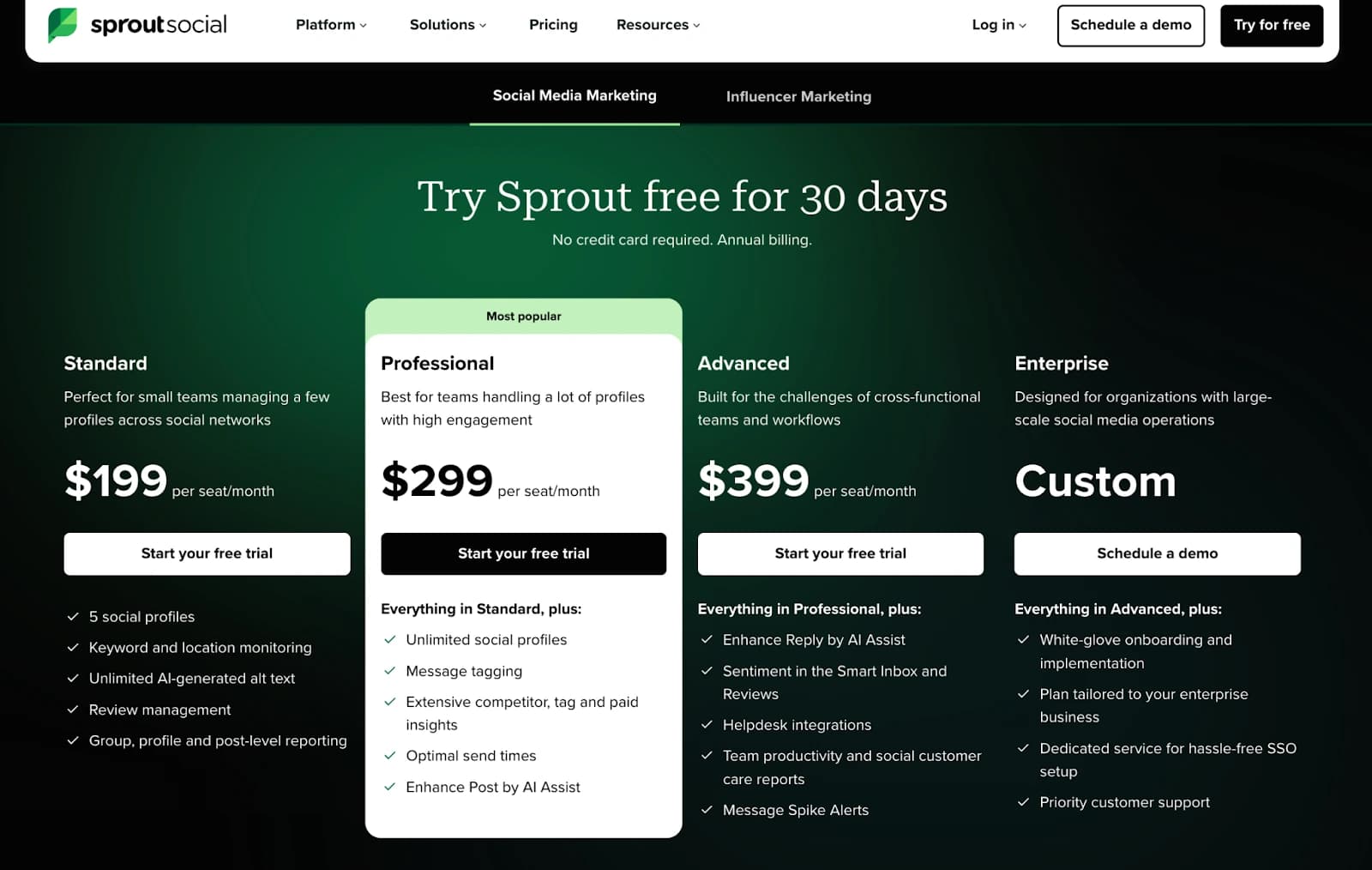
It's important to note that this pricing is for a single user "seat." Additional users can be added to the plan, but each will incur the exact per-user cost.
Understanding the limits of the Professional plan ($299/user/month, billed annually) is key to avoiding unforeseen needs for a plan upgrade.
For example, in-depth reports on team response times and other customer service metrics are locked in the higher-tier plans.
Agorapulse
$119/ month (billed annually)
Agorapulse is relatively affordable and a good software option for teams new to social media management tools. It is often one of the options users look for when looking for Sprout Social alternatives.

Each additional user is charged at the same rate as the first user.
With the professional plan ($119/month/ user), you can assign or route specific content to team members or stakeholders for one-step approvals.
The advanced plan ($149/month/user) locks in features like bulk scheduling and multi-step approval workflows.
The professional plan has standard reports like social profile reports and post-performance reporting. However, it lacks ‘Power Reports’, a key feature of the Advanced plan. These Power Reports let you create fully customized reports that compare results across multiple social networks and/or profiles in one view.
My take:
From a price standpoint, Sprout is a more expensive investment that doesn’t offer a monthly billing option. Agorapulse is more budget-friendly, with its entry-level plan being less expensive than Sprout Social's.
Sprout Social may be an option for those enterprises with procurement processes that prioritize a tool’s brand huge reputation. It is a market leader, and this comes with a certain premium price point.
I would say that beginner teams are better off with Agorapulse, as it’s a cost-effective option with an easy interface. Keep in mind that this tool has fewer automations and integrations compared to Sprout.
Statusbrew has become a go-to option for teams seeking advanced features like Sprout at a fair cost starting at $129 per month (3 users, 10 profiles). There is flexible pricing for teams or agencies with multiple profiles or users.
Customer Support
Sprout Social
All of Sprout Social’s plans come with 24/5 live phone and chat support. They provide users with tiered customer service through 3 main modes:
Self-Service: All users have access to a comprehensive online Help Center, a learning portal with training courses, and a community forum for peer support.
Direct Support: Customers can get assistance through email tickets, live chat, and also by contacting their support team on social media.
Premium Support: Customers on higher-tier plans receive priority service, which includes phone support and a dedicated customer success manager for personalized guidance.
Enterprise (custom pricing) and some Advanced plan ($399/month/user) customers are assigned a dedicated support personnel who provides personalized onboarding and strategic guidance. Customers on higher-tier plans often receive prioritized service, meaning their tickets and calls are moved to the front of the queue for faster response times.
Its support network is broad and professional, but the customer support process can take too long. A common complaint that’s raised is the unreliability of responsive human agent support.
It can be difficult for teams that have chosen a premium-priced product in the market and need quick help with issue resolution.
This is a review of the platform’s support quality on G2.

This might be an issue for teams that are not equipped to handle the learning curve for a tool like Sprout.
This review points to an aspect of Sprout’s customer service that leaves room for improvement.
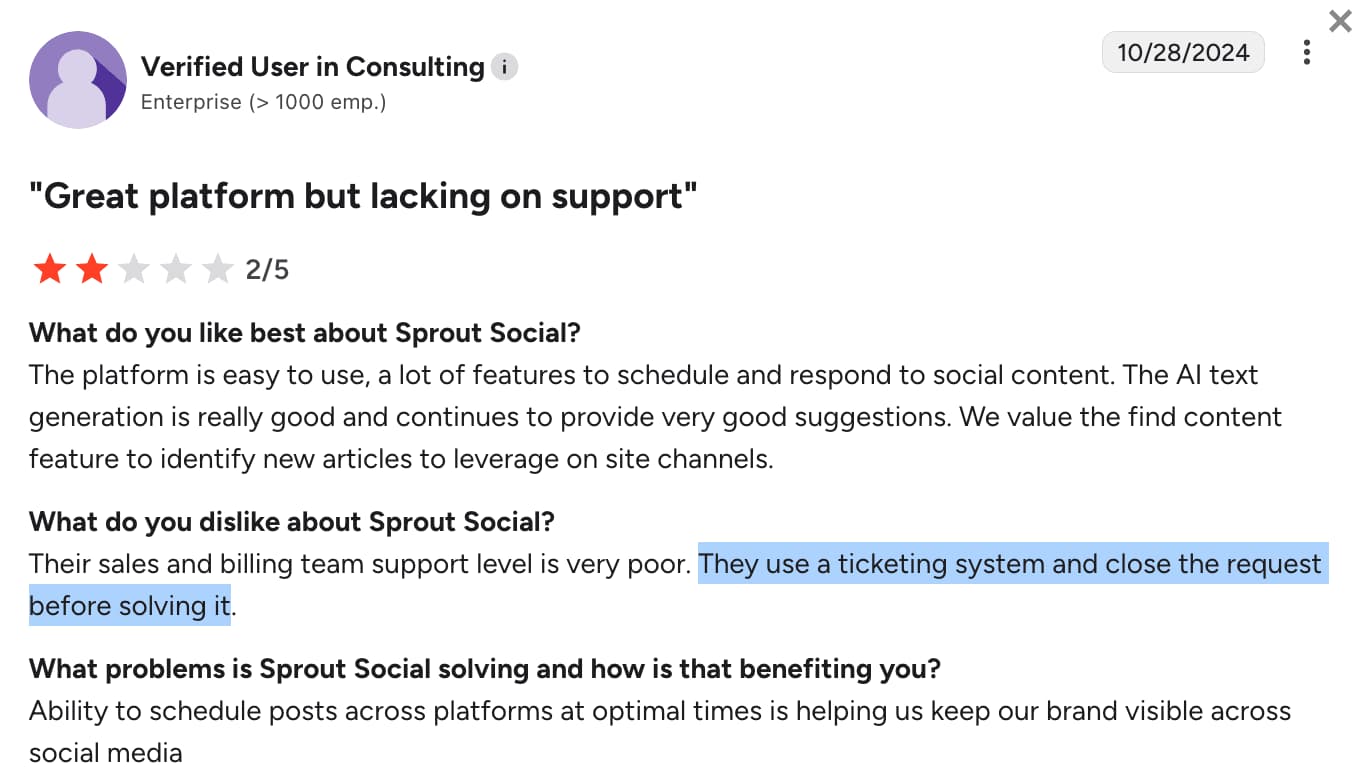
Agorapulse
The software’s support has a good reputation among smaller teams and agencies. This makes sense because, in contrast to Sprout, the tool has decently responsive human agent support across its paid plans.
The mid-tier professional plan offers a 2-hour support window (an add-on at Sprout) and chat support.

Although some users would like to see more training videos on the interface’s functions, Agorapulse’s support quality remains one of its strengths.
My take:
For new social media tool adopters or any business where rapid customer support is non-negotiable, Agorapulse is the better choice over Sprout Social.
Sprout's customer support is not as robust or accessible as it should be. Customers expect a premium, highly responsive support system, which is not always delivered.
Statusbrew is a pragmatic alternative in this scenario, offering responsive human support, 22*6 availability via Live chat, and Zoom calls.
With a support team spread across 4 time zones, users are able to rely on support teams for quick resolutions. The team also offers onboarding and training assistance in all plans for team members, in contrast with Agorapulse, which offers onboarding assistance only to custom plan users.
Reporting & Analytics
Sprout Social’s analytics dashboard is built for in-depth analysis. The user interface can feel more complex, but it’s designed for users who need to dig into specifics. Sprout has a wide range of pre-built report templates that cover the most common analytics needs.
The platform's ‘Report Builder’ is a standout report customization feature. It allows users to create custom reports from scratch by choosing from hundreds of metrics and visualizations.
The Professional plan ($299/month/user) includes reports that let you benchmark your performance against competitors, on metrics like engagement and audience growth.
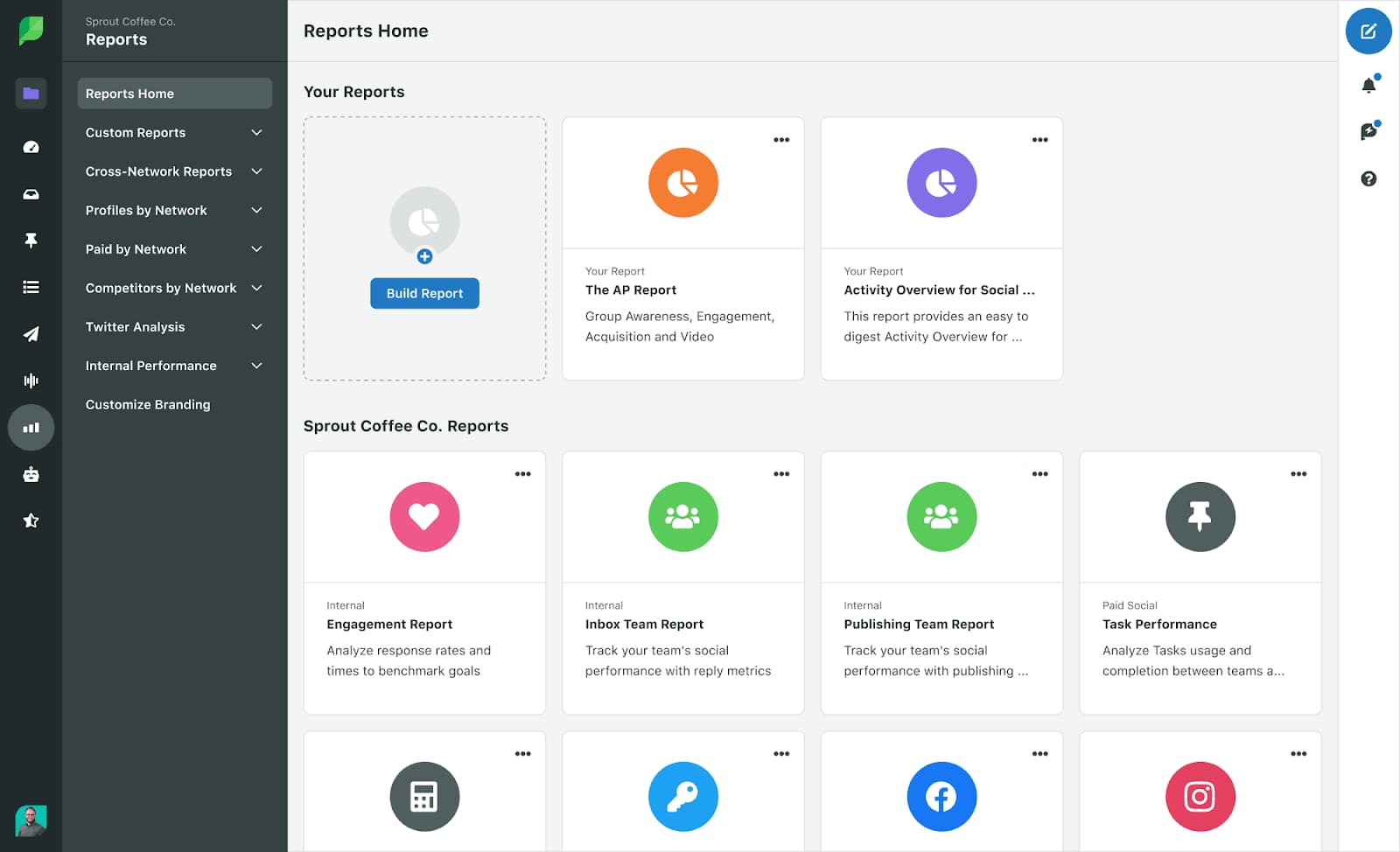
You would have to subscribe to the Advanced Plan at $499/month/user to access report customizations.
Sprout Social’s cross-platform reporting features are known for being detailed. The extent of customization in the Professional Plan ($399/ month/ user) is that reports can be adjusted to specific date ranges, allowing you to track performance to be exported as PDFs or CSVs.
The Professional Plan's main value comes from adding competitive, paid, and campaign-level (tag) reporting, which are significant steps up from the Standard plan ($199/month/user).
When it comes to trend analysis, Sprout Social’s dashboard is able to pinpoint spikes and dips.
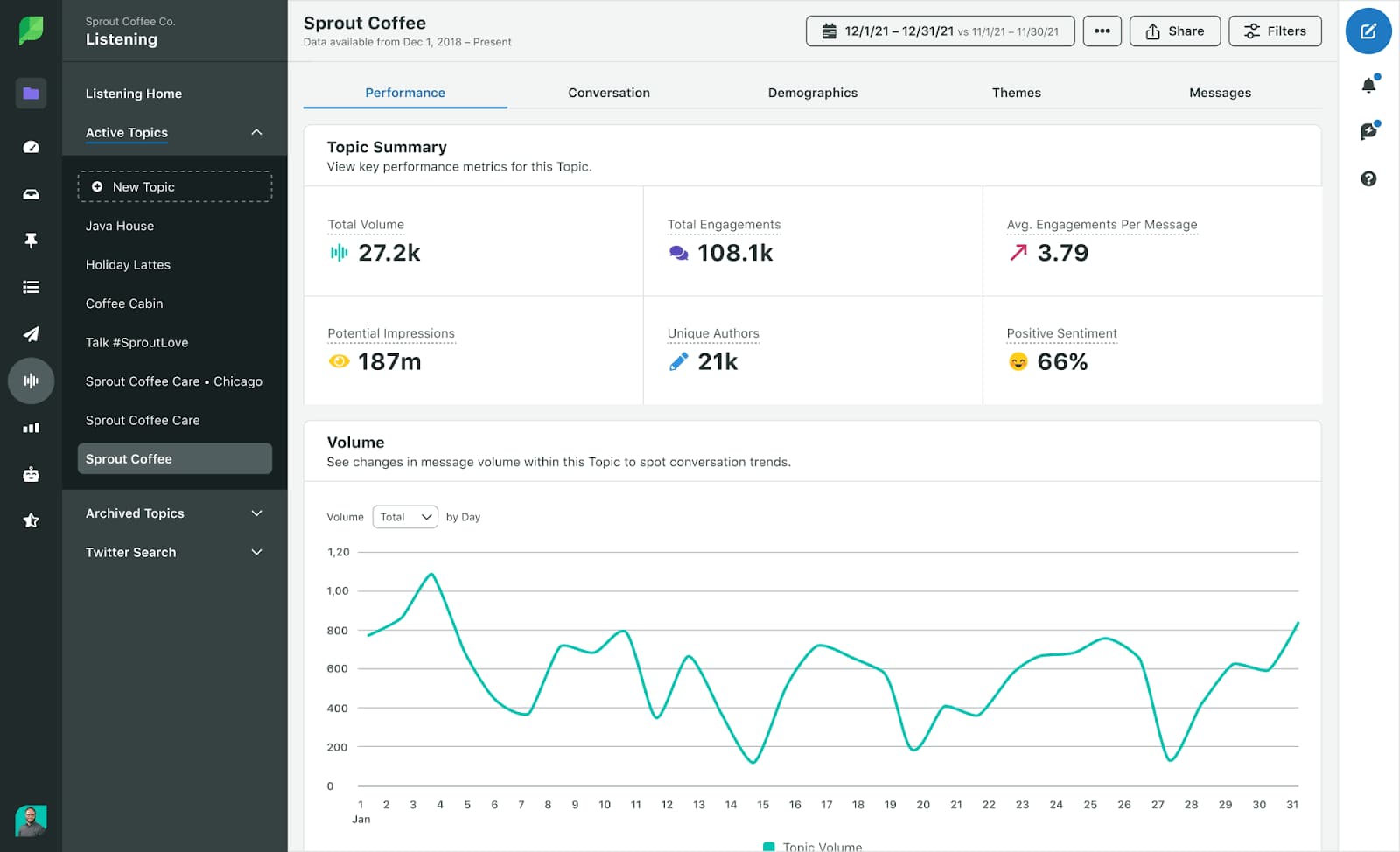
Agorapulse’s analytics requires you to connect your Google Analytics account to use the Social Media ROI Dashboard. The purpose of this integration is to understand the actual business value of your social media efforts.
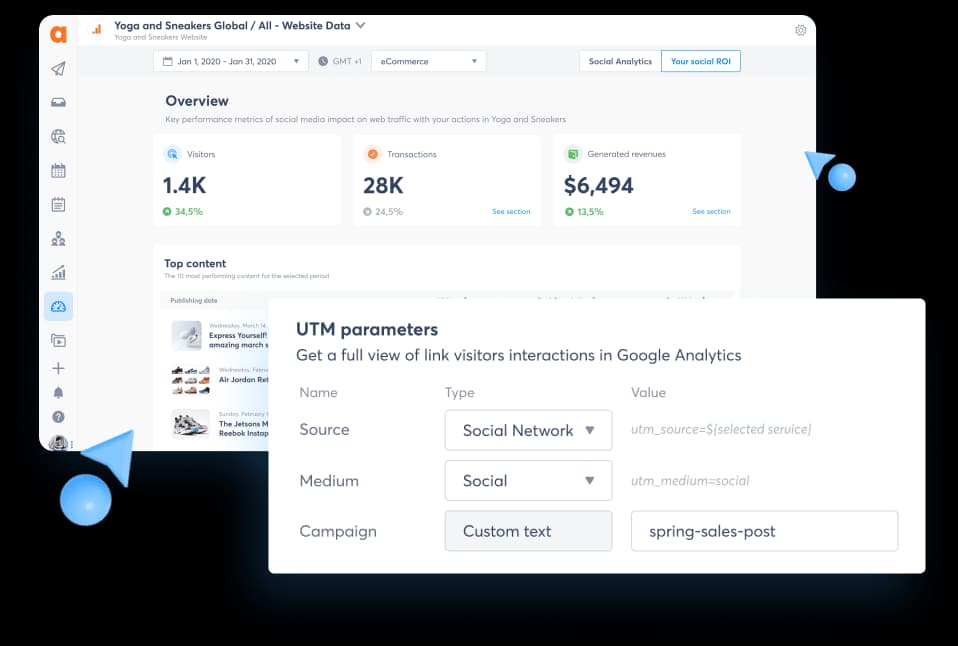
Tracking link clicks, conversions, revenue, traffic, and so on becomes easier. You can also compare performance across different social channels.
The core difference is in the final product. Agorapulse provides a ready-made, easy-to-read ROI dashboard that does the work for you.
My take:
Sprout is not straightforward or simple. The platform requires you to be an active builder. You'll need to learn which toggles to flip and data points to use to get what you need.
Yes, you can create custom reports by selecting specific aspects from a wide array of data points. However, many report customizations are locked at a higher price point.
Agorapulse's reporting highlight is its simplicity. It is geared towards proving social media ROI, making it ideal for companies focused on lead generation or smaller agencies that must demonstrate a clear return on investment (ROI) to their clients.
Sprout’s reporting is customer service and team-performance-oriented, which is more useful for social customer service teams.
As far as analytics and reporting are concerned, I would say Sprout is more detailed than Agorapulse. It has powerful reporting tools, but requires considerable time investment to train social media teams in its usage.
Statusbrew’s Premium Plan ($229/month/6 users) provides a granular view of social media performance with over 250+ metrics and 20+ predefined reports. It’s an affordable alternative to Sprout’s Professional Plan ($299/month/user). You can also securely share report links with external stakeholders and control the data they can access.
Inbox & Engagement
Sprout's inbox is designed with a robust set of filters, allowing users to create custom views based on keywords, message sentiment, assigned user, or message type.
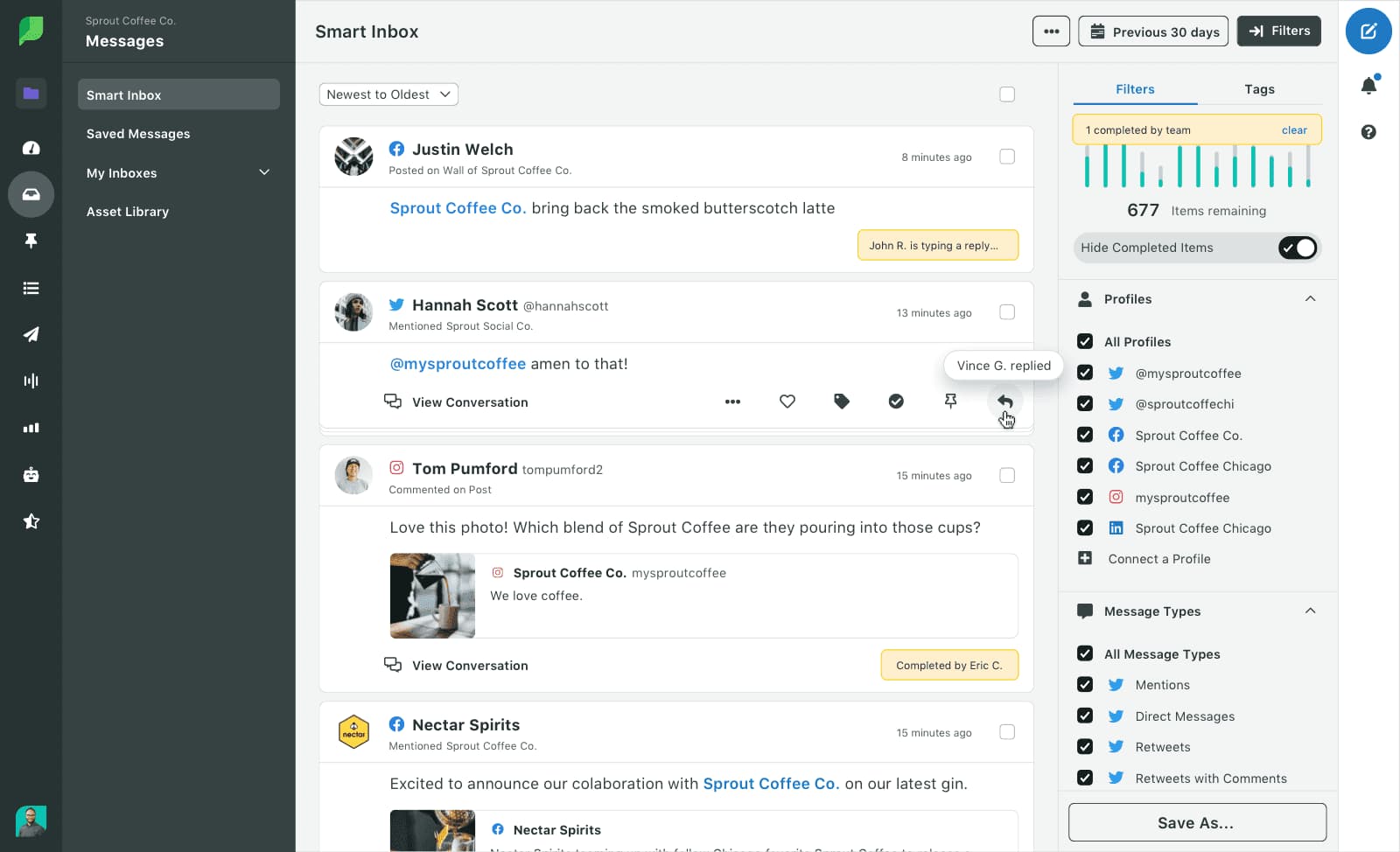
This makes it ideal for large teams that need to redirect messages and analyze conversations in-depth. The user experience is built for efficiency, but it can feel overwhelming for new users.
You can set up automated rules in the Smart Inbox to:
Tag incoming messages for better customer care routing.
Complete messages to keep your inbox view clear.
Automated alerts
Hide inappropriate messages or those that don't require action.
You can set up Inbox Rules to ‘tag’ and ‘complete’ incoming messages based on specific keywords and set up Automated Alerts. These features are part of the Automated Rules feature, which is available in the Sprout Social Professional Plan ($299/month/user).
One drawback is that features like ‘Rule Templates’, ‘Message Spike Alerts’, and ‘Sentiment Analysis’ in the Smart Inbox are reserved for the Advanced Plan ($399/month/user).
Agorapulse’s social inbox is designed for efficiency. It enables the user to manage a high volume of social conversations from one place.
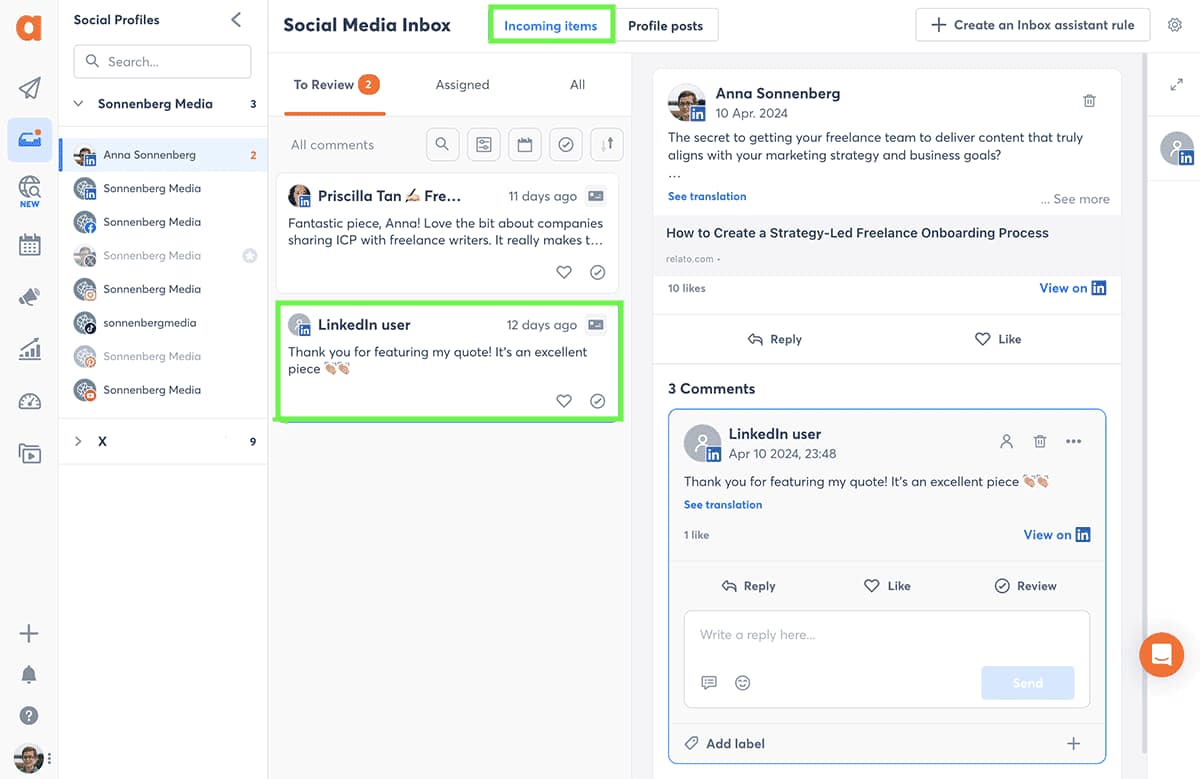
The UI of their social inbox is popularly praised for its navigation and ease of use. Its design purpose is to help you reach ‘inbox zero’ by giving you the tools to quickly review, respond to, and clear messages.
However, some users find it challenging to have a comprehensive overview with Agorapulse’s inbox- especially agencies with multiple social profiles.
A simple task of reviewing all conversations means that you will have to click on each profile to be informed of the corresponding conversations. There is a risk of oversight and missed messages/ communication.
For the Professional plan, users have access to Automated Moderation, which lets you create one automated moderation rule per social profile. This includes setting up conditions such as keywords, mentions, or links to trigger the automation. This reduces the day-to-day administrative tasks in the workflow.
However, you are limited to 1 rule, with 1 trigger condition per rule under the mid-tier plan.
If you need more flexibility or additional rules, you would need to upgrade to a Custom Plan, as it isn’t available in the Premium ‘Advanced’ plan either.
My take:
Sprout’s interface leans more towards customizable workflows, whereas Agorapulse leans towards ease in day-to-day navigation.
Sprout Social offers robust filtering for large teams, with key features gated by its high-cost plan. Agorapulse is easy to use and efficient in achieving 'inbox zero', but lacks a ‘unified inbox’ for agencies managing multiple profiles.
Sprout is great for large teams that need detailed filters and deep analysis. However, I find it its most useful automation features are expensive.
On the other hand, Agorapulse is designed to help you clear your inbox quickly. For me, the main drawbacks are that it’s easy to miss messages across different profiles, and the automation is limited.
Sprout is the better choice for large, data-focused teams, while Agorapulse is a better fit for smaller businesses that just want a simple inbox.
Statusbrew is one tool that delivers value in automation features. The Rule Engine is a core automation feature in Statusbrew's Engage inbox. You can set up custom triggers and automated actions to ensure that the right conversations are assigned to the right people.
Collaboration
Sprout Social's Professional plan includes a robust set of collaboration features, such as a content calendar for team management, an intuitive message approval system, and a shared inbox with real-time activity updates.
Conversations from the Smart Inbox can be turned into tasks and assigned to specific team members. The collision detection feature lets users view real-time indicators on the message surface when a teammate is viewing or responding to a message.
This prevents duplicate replies in real-time.
In the mid-tier plan, users can employ a flexible approval structure to set up internal and external workflows. They can also submit, review, collaborate on, and approve posts, which can undergo multiple layers of review. Here’s an example of creating an approval workflow in Sprout.
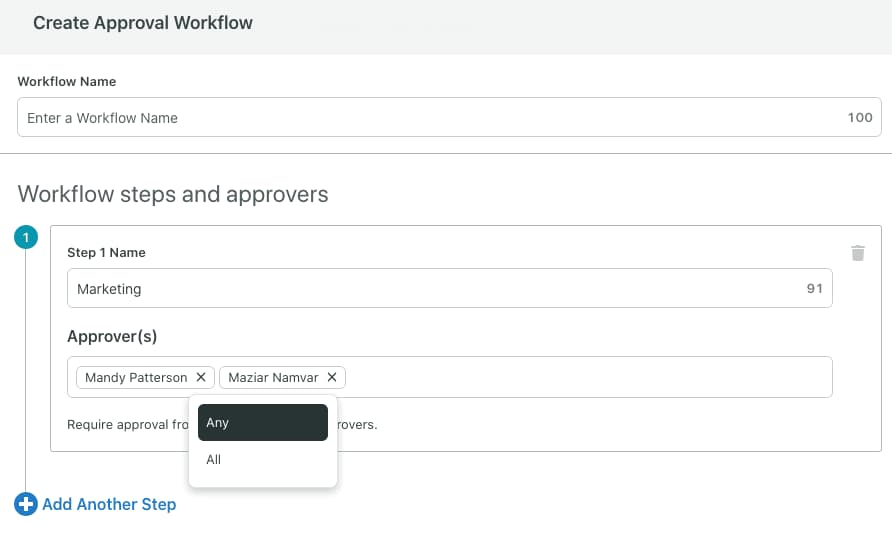
You can create multiple workflows and customize multi-step approval.
A big drawback is that you can’t use Sprout's Professional Plan ($299/month/user) to collaborate with external approvers. This feature is only available with Sprout's Advanced Plan ($399/month/user). Professional plan users can share report links with external stakeholders.
Agorapulse also allows you to assign any inbox item to a team member for a reply or action. The interface is also equipped with collision detection and shows who is currently viewing an item.
The Professional plan is limited in its approval workflows ($119/month/user). The mid-tier plan has a single approval system, and multi-level approvals are available only in the advanced plan ($149/month/user).
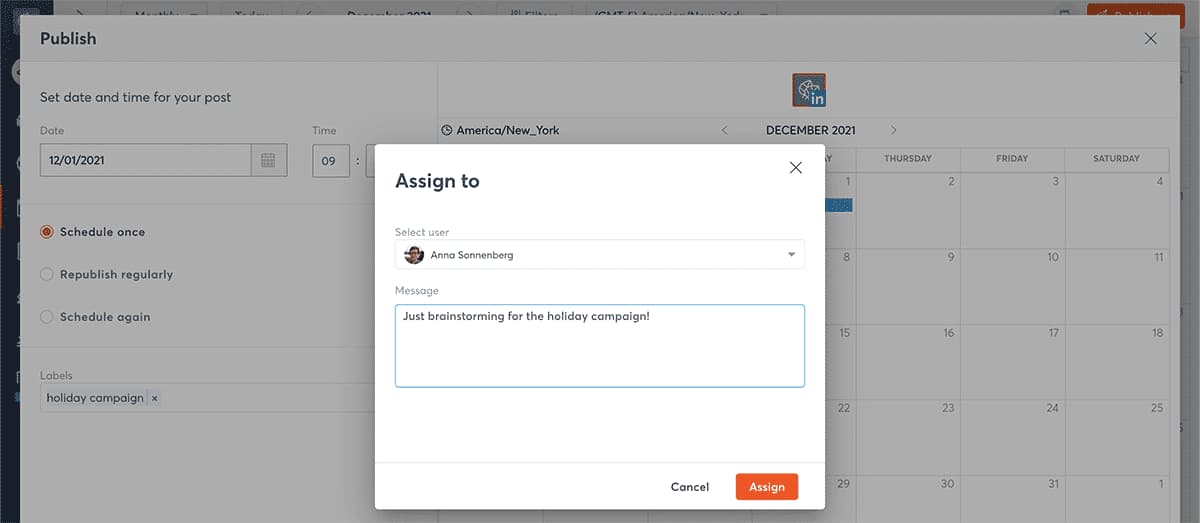
A big drawback is that the Professional plan doesn’t have the capability to create a built-in system that requires a manager's approval before publishing.
This critical governance feature is only available with their Advanced Plan.
Furthermore, client access to collaboration tools, such as a "Shared Calendar" for external approvals, is unavailable in both the Professional ($119/month/user) and Advanced ($149/month/user) tiers. This functionality is reserved for the Custom plans, as with Sprout.
My take:
Sprout Social offers a comprehensive internal collaboration suite with advanced, multi-step approval workflows. Since Agorapulse matches Sprout's core inbox features like collision detection and tasking, the choice depends on your need for in-depth internal approvals.
Sprout’s workflow is built for efficiency in a large-scale, complex team environment. Agorapulse’s workflow is designed to be direct, favoring efficiency over customization.
Statusbrew addresses this need for internal approvals and rule engine capabilities with its Premium Plan ($229/month/6 users). The platform’s standout feature is the Engage Rule Engine, which automates team workflows.
This tool lets teams create multi-layered workflows, thereby helping growing businesses with scalability.
Publishing & Scheduling
Sprout Social’s publishing function is made easier with the Social Media Calendar. It helps users manage their social media content and schedule posts up to 180 days in advance. The calendar is color-coded and sorted by filters, which lets you keep tabs on multiple platforms.

With OpenAI integration, you can use AI Assist to automate parts of the writing process. It can generate post ideas, rewrite text in different tones, or shorten content for different platforms, speeding up content creation.
From this single window, you can directly access the Asset Library, apply labels for reporting, and select your scheduling options, including ‘Post Immediately,’ ‘Auto-schedule with ViralPost,' or pick a specific future date and time.
The mid-tier Professional plan does not include external approval workflows.
Agorapulse’s calendar has a clutter-free design that's ideal for new users. However, its layout is less customizable than Sprout and other platforms.
Agorapulse has fewer metadata, like tags and labeling, to categorize and filter posts.
This Sprout feature allows users to connect a post with a specific marketing campaign, which comes in handy for performance reports. In Agorapulse, a user would have to use a label for this, and it doesn't have the same integrated reporting functionality.
Both tools offer the optimal-time publishing feature. However, the AI writing assistant feature offered by Sprout in the mid-tier plan is only available in Agorapulse's advanced plan.
Sprout’s bulk-scheduling feature lets you plan up to 350 posts at one go, using a CSV upload within the framework of its Publishing Calendar.
Agorapulse lets you schedule up to 200 posts with a CSV upload in all of its plans.
My take:
Here are the key differences between Sprout Social and Agorapulse with the ‘Publishing’ feature:
The first one is the overall depth of functionality. If you’re opting for the less expensive Agorapulse option, you'll need to be proactive in figuring out how to create a system within its limitations.
The labeling process would have to be rigorous from the user’s end. All in all, be prepared for functional workarounds if you choose to go with Agorapulse.
Statusbrew is also one of the leading social media scheduling tools. It offers modern publishing and network-native features, including content tagging, the Best time to post, content and media editing, approval workflow, and custom calendar boards.
Sprout Social vs Agorapulse: According to the team/business type
Small Teams / Freelancers:
Need intuitive scheduling, easy engagement, and responsive support, without complexity.
Recommended: Agorapulse is suitable for solo professionals and small teams looking for an affordable and user-friendly interface.
Growing businesses/ Agencies:
Require multi-client management, content approvals, and robust reporting.
Recommended: Agorapulse is the more affordable choice for client management, flexible workflows, and competitive pricing tailored for agency needs.
Large Enterprises
Demand advanced analytics, comprehensive social listening, strong security (SSO), and detailed permissions for large-scale social operations and data compliance.
Recommended: Sprout Social is a good fit for companies with big budgets.
The Bottom Line
Choose Agorapulse if:
You have a small to mid-sized team and a modest budget.
Your primary goals are efficient engagement, content scheduling, and proving ROI.
You have a simple workflow and don't require a complex approval workflow at your current stage.
Choose Sprout Social if:
You are a mid-sized team with a larger budget that is poised for significant growth.
Your priority is brand consistency, structured internal workflows, and multi-layered approvals.
You need deeper analytics and competitive benchmarking to inform your business strategy.
A Third Option
If you have tried Agorapulse and Sprout Social and are now looking for a tool with better pricing than Agorapulse but also offers the same features as Sprout Social, Statusbrew’s Standard plan may be right.
The bundled cost structure ensures transparency, preventing surprise expenses from add-ons.
Statusbrew has 1:1 feature parity with Sprout Social and delivers responsive customer service at a better pricing model. Here are the top 4 reasons why users make the switch to Statusbrew:
20+ reporting templates, 100+ Widgets, 250+ KPIs tracked.
Client/agency-friendly workflows. Unlimited workspace for multiple clients.
Enterprise security: SSO, permissions.
Transparent & bundle pricing, not per-user restrictive pricing.
Per profile custom price for multiple profile agencies/teams.
22*6 live human available via Live Chat, Email & Zoom
It offers scalability with multi-channel scheduling, detailed analytics, and strong team collaboration tools, features that typically come at a higher cost on other platforms. Importantly, Statusbrew is a cost-effective option for enterprise-grade analytics, extensive integrations, and security features for larger organizations.
FAQs
Why do people leave Sprout Social?
The most common reasons are its high pricing and the delayed customer service response time.
Why do people leave Agorapulse?
The high per-person fee to add new users to the existing plan is one of the issues. Users are also not satisfied with the analytics feature and the occasional technical bugs.
Which platform offers the best value for small to mid-sized marketing teams?
For most small to mid-sized marketing teams, Agorapulse generally offers the best value. The primary reason is its pricing model and feature suite, which provide essential social media management tools without the steep per-user cost and complexity.
While Sprout Social is more powerful, its value is often better utilized by larger, more complex organizations.
In this context, Statusbrew’s Standard or Professional plans are preferred by small to mid-sized teams. It offers scalability, multi-channel scheduling, analytics, and team collaboration tools- all of these at an affordable price.
Which social media tool has better analytics and reporting?
Sprout Social offers in-depth and extensive analytics. Its reports are highly detailed and designed for data-driven teams.
Agorapulse excels at providing clear, actionable reports with a standout feature for calculating the monetary ROI of your social media efforts.
What are some Hootsuite alternatives?
Sprout Social is a premium alternative, offering a more polished user interface and superior analytics for teams ready to upgrade. Agorapulse stands as a strong, user-friendly alternative known for its efficient social inbox and clear, ROI-focused reporting.
Statusbrew is a powerful Hootsuite alternative for teams focused on engagement, offering an advanced Rule Engine and automations at a reasonable cost.
What is the best tool for social listening and brand monitoring?
Sprout Social provides an advanced and powerful social listening suite, ideal for in-depth market research and tracking broad industry trends.
Agorapulse offers excellent and very accessible brand monitoring, perfectly suited for tracking direct mentions, brand conversations, and competitor activity.
Statusbrew also offers comprehensive social listening, uniquely allowing its sentiment analysis to trigger automated rules for real-time crisis management or lead routing.
7. What are some affordable social media tools for startups?
Agorapulse is significantly more affordable for startups due to its team-friendly pricing that doesn't charge per user. Sprout Social is a premium enterprise tool, and its steep per-user cost is often outside the budget for most early-stage companies.
Statusbrew is also a highly affordable and scalable option for startups, as its Standard plan includes multiple users and enterprise-grade automation features from the start.





